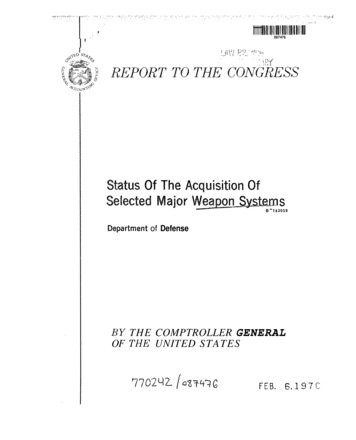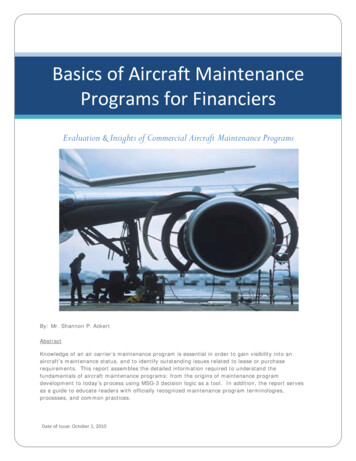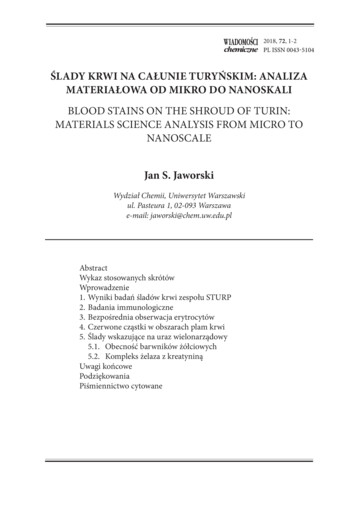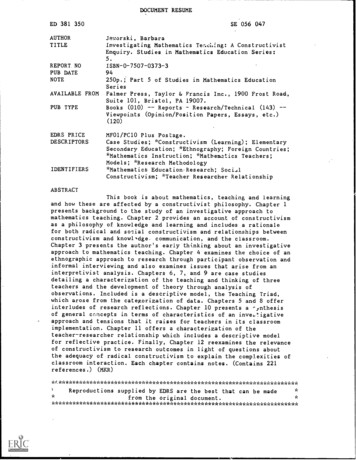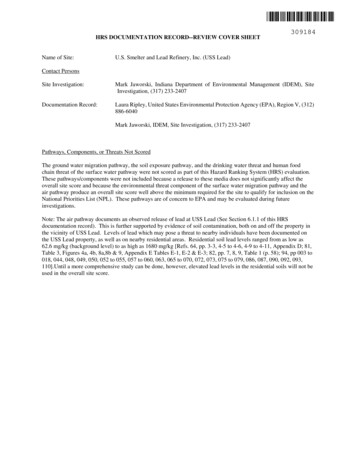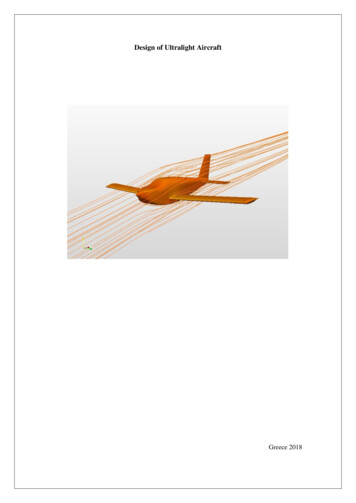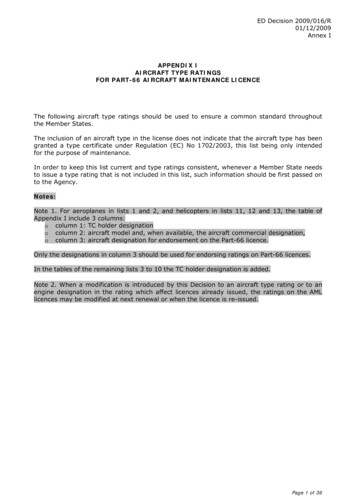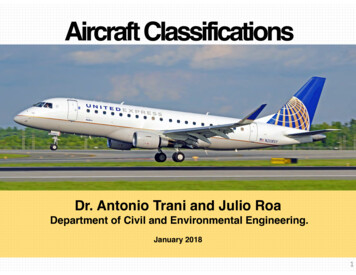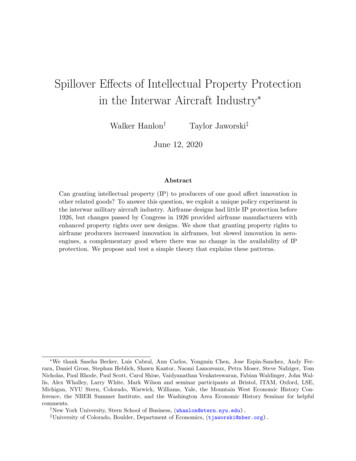
Transcription
Spillover Effects of Intellectual Property Protectionin the Interwar Aircraft Industry Walker Hanlon†Taylor Jaworski‡June 12, 2020AbstractCan granting intellectual property (IP) to producers of one good affect innovation inother related goods? To answer this question, we exploit a unique policy experiment inthe interwar military aircraft industry. Airframe designs had little IP protection before1926, but changes passed by Congress in 1926 provided airframe manufacturers withenhanced property rights over new designs. We show that granting property rights toairframe producers increased innovation in airframes, but slowed innovation in aeroengines, a complementary good where there was no change in the availability of IPprotection. We propose and test a simple theory that explains these patterns. We thank Sascha Becker, Luis Cabral, Ann Carlos, Yongmin Chen, Jose Espin-Sanchez, Andy Ferrara, Daniel Gross, Stephan Heblich, Shawn Kantor, Naomi Lamoreaux, Petra Moser, Steve Nafziger, TomNicholas, Paul Rhode, Paul Scott, Carol Shiue, Vaidyanathan Venkateswaran, Fabian Waldinger, John Wallis, Alex Whalley, Larry White, Mark Wilson and seminar participants at Bristol, ITAM, Oxford, LSE,Michigan, NYU Stern, Colorado, Warwick, Williams, Yale, the Mountain West Economic History Conference, the NBER Summer Institute, and the Washington Area Economic History Seminar for helpfulcomments.†New York University, Stern School of Business, (whanlon@stern.nyu.edu).‡University of Colorado, Boulder, Department of Economics, (tjaworski@nber.org).
1IntroductionGranting property rights for new inventions is a central feature of innovation systems.Standard theories of innovation emphasize how intellectual property (IP) rights incentivizeinnovation by providing market power. Market power allows firms to extract rents thatcompensate for investment in innovation. Standard theory also predicts that granting marketpower to producers of one type of good will impact rents available to firms producing eithercomplementary or substitute goods. A direct implication is that granting IP to one groupof producers will change the rents available–and the incentives to innovate–for producersof related goods. This suggests that there may be important spillovers from granting IPprotection to goods on innovation activity in complement or substitute goods through marketpower channels.Several recent debates highlight the connection between access to IP protection, marketpower, and innovation. For example, numerous commentators have argued that the marketpower of the largest tech companies, which is in part due to the IP portfolios they hold,may be reducing innovation in complementary products (e.g., smartphones and smartphoneapps).1 More broadly, the International Monetary Fund recently warned that rising marketpower in advanced economies has the potential to stifle innovation.2 Similar concerns haveappeared in discussions about the importance of common ownership.3Despite these concerns, and a large literature on IP protection and innovation, there islittle empirical evidence that addresses the potential spillovers of IP protection offered toproducers of one type of good on innovation in related (e.g. complementary) goods. Instead,existing research focuses on the impact of IP protection within classes of similar products.For example, Williams (2013) and Sampat and Williams (2019) quantify the impact of IPrights on follow-on innovation in human genes and Gilchrist (2016) considers the impactwithin classes of competing pharmaceutical drugs.4 In this paper we study spillover effectsof IP protection that arise between markets linked by complementary goods produced bydifferent firms.Research that aims to quantify the direct and spillover effects of IP protection on innovation presents three challenges. The first challenge is to find a setting where IP protectionchanges for producers of one good, but not for producers of related goods. We focus on1See, e.g., “Big tech has too much monopoly power – it’s right to take it on,” Kenneth Rogoff, TheGuardian, April 2, 2019 and “How the Frightful Five Put Start-Ups in a Lose-Lose Situation,” FarhadManjoo, New York Times, Oct. 18, 2017.2World Economic Outlook (2019), Ch. 2.3See, e.g., Vives (Forthcoming).4See Williams (2017) for a survey of this literature. In addition, a number of papers examine how changesin IP protection affect the price and availability of existing products (e.g., see recent work by Chaudhuri,Goldberg and Jia (2006) and Duggan, Garthwaite and Goyal (2016)). This line of research is different fromour study, which focuses on the impact of IP protection on innovation.1
one setting, the US aircraft industry during the interwar period, that offers this vital feature. A functional powered aircraft requires both an airframe and one or more aero-engines.In the period we study–and continuing through to today–these two elements are typicallyproduced by different companies and purchased separately (e.g., Boeing produces airframes,while Pratt & Whitney produces engines).Our study takes advantage of a unique natural experiment during this period. Thepolicy we study originated at the end of World War I, when allegations of war profiteeringled Congress to limit IP protection available to airframe producers of military designs, whichrepresented the vast majority of the aircraft market at that time. Companies that produceda new airframe design did not have an exclusive right to their design. Rather, it was putout for competitive bidding. For example, when the Glenn L. Martin Company designedthe MB-3 bomber and the War Department decided to purchase 200 versions of this plane,the production contract was put out for competitive bidding and won by Curtiss, Martin’scompetitor. The IP regime changed in 1926, when Congress altered the policy to givefirms producing new designs accepted by the military exclusivity in the production contract.Importantly, the change in IP protection only applied to airframe producers while engineproducers had access to IP protection over the entire period. This allows us to use thispolicy to understand the impact of changes in IP protection–by which we mean propertyrights over a new idea or design–for airframe producers on innovation in both airframes andcomplementary aero-engines.A second challenge in studying this question is that standard measures of innovationused in the literature (e.g., patents) critically depend on the IP regime. These cannot beused to track the impact of changes in the IP regime on innovation. Our setting allows us toget around this issue by measuring innovation directly using data on the performance characteristics of the airframes and engines. We draw on several sources to construct standardindustry performance measures for airframes (e.g., wing load, calculated as the gross weightper wing area) in distinct market segments (e.g., fighters) as well as for aero-engines (e.g.,horsepower per unit of engine displacement).The third challenge is that changes in airframe or aero-engine innovation in the UnitedStates may not be the result of IP policy, but instead reflect broader changes in the worldtechnology frontier that ultimately diffuse to the United States. However, in the interwarperiod, many countries operated as mostly isolated markets for military aircraft. In eachcountry, the military purchased airframes and engines almost exclusively from domesticproducers. While firms in each country were aware of the broader technological trends, theywere exposed to different institutional environments. This allows us to compare airframeand aero-engine innovation in the United States before and after the change in IP policywith other countries that did not experience similar changes.2
We formalize the incentives to innovate in a simple theoretical model that emphasizes theprofit mechanism central to theories of economic growth and innovation (e.g., Romer, 1990;Grossman and Helpman, 1991; Aghion and Howitt, 1992). In our model, the motivationof airframe producers to innovate are the expected profits associated with new invention.When airframe producers do not have access to IP protection, the price of airframes is theperfectly competitive price (consistent with the competitive bidding regime we observe);with IP protection, airframe producers with the best designs can extract additional rents.However, when airframe producers are able to extract greater rents, this reduces the profitsavailable to engine producers and their incentive to innovate.Our main empirical analysis documents two patterns consistent with the theory. First,after IP protection became available to American airframe producers, the rate of improvement for key performance measures accelerated. This is apparent either when focusing onlyon changes within the United States over time or comparing the United States to othercountries. Prior to 1926, innovation in airframes was typically slower in the United Statesthan in comparison countries; after 1926, the rate of innovation was faster. This suggeststhat providing IP protection had a positive effect on technological progress in airframes, aspredicted by the theory. Second, we find that the rate of innovation in aero-engines slowedafter 1926. Again, this pattern appears when looking at the United States over time, as wellas relative to available comparisons countries. Since there was no change in the availabilityof IP protection for engine technology, we attribute this slowdown in the United States tothe spillover effects of granting IP protection to airframe producers.While our results are consistent with the theory, there are alternative stories that canrationalize the pattern of airframe and aero-engine innovation that we observe. For example, one might worry that these patterns were due to changes in the civil and commercialaircraft market, to changes in the overall level of military expenditures, to other changes inprocurement policy, or perhaps because engines and airframe performance were substitutes.We discuss each of these potential alternatives in detail and provide evidence suggesting thatthey are not likely to be behind the patterns we document.To provide further support for the profit mechanism proposed in our model, we deriveadditional testable predictions from theory that can be taken to the data. Specifically,we show that our model predicts that granting IP protection to airframe producers generates incentivizes for mergers between airframe and aero-engine producers, which we referto as “vertical-complement” mergers.5 When IP protection allows airframe producers toextract rents for new designs this gives rise to a classic double-marginalization problem,which provides incentives for airframe and aero-engine producers to merge. In the absence5We use this terminology because, while mergers between aero-engine and airframe producers do not fitthe classic definition of a vertical merger, since these inputs were typically purchased separately, they aresimilar to classic vertical mergers in important ways.3
of IP protection for airframes, no such problem emerges and therefore there is no incentivefor mergers. The model also predicts that mergers should exhibit a particular pattern ofmatching between airframe and engine producers.Our setting offers a particularly useful environment for testing this prediction becausethe permissive antitrust regime meant that firms that wanted to merge faced few regulatorybarriers. To test this prediction, we reconstruct histories of all airframe and aero-engineproducers through World War II. Prior to the change in 1926 there were two main producersof military-grade aero-engines in the United States: Wright and Pratt & Whitney. By 1929,both had merged with major airframe producers: Wright combined with Curtiss to formCurtiss-Wright Corporation and Pratt & Whitney merged with Boeing as well as severalsmaller airframe producers to form United Aircraft. We show there was no similar patternof mergers in the United States before 1926 or after 1930; there was also no similar pattern ofmergers between engine and airframe firms in the US civilian market just after 1926, nor dowe see a similar pattern of mergers in comparison countries. This suggests mergers betweenmilitary airframe and aero-engine producers in the United States were linked to the changesin IP protection. Moreover, the pattern of matching between airframe and engine producersthat we observe also matches the predictions of the theory.Taken together, our findings make several contributions to the existing literature. First,we provide new evidence for spillovers from IP protection, and specifically evidence that sucheffects arise through a link between market power and innovation decisions across markets.This has important implications for understanding the interaction between IP and antitrustpolicy and, ultimately, the direction of innovation and economic growth. Methodologically,there is a large literature that quantifies the effect of IP protection by comparing similargoods, which may overstate (understate) the total amount of additional innovation generatedby IP protection if these goods are complements (substitutes). We also provide the firstquantitative assessment of this particular change in IP protection, which has been the subjectof debate (Vander Meulen, 1991; Patillo, 1998). In particular, we highlight the role ofspillovers in determining the performance characteristics of US aircraft–airframes and aeroengines–leading up to World War II.Second, we contribute to research on the relationship between innovation and market size,including seminal work by Schmookler (1966), and Acemoglu and Linn (2004) and Finkelstein (2004), more recently. In our setting, IP protection for airframes reduces innovationin aero-engines by reducing residual demand. There is also closely related work beginningwith Schumpeter (1942) and Arrow (1962) on the effect of competition on innovation. Existing empirical evidence frequently takes competition or market concentration as given andestimates the effect on innovative activity (e.g., Blundell, Griffith and Van Reenen, 1999;Aghion, Bloom, Blundell, Griffith and Howitt, 2005; Aghion, Blundell, Griffith, Howitt and4
Prantl, 2009; de Bettignies, Gainullin, Liu and Robinson, 2018). Our focus on the effectof IP protection on firms producing complementary goods is novel. In this context, weprovide evidence for the endogenous response of market structure to IP protection throughvertical-complement mergers.6Currently, evidence of how the effects of IP protection can spillover across complementarygoods is very limited. The closest available study on this topic that we are aware of is recentwork by Moscona (2019), which studies the impact of a change in patent protection applyingto US agriculture and provides evidence of spillover effects on complementary goods. Onedifference in our study is that we investigate the mechanisms behind the spillover effects weobserve, both theoretically and empirically. Interestingly, the spillovers we observe in theaircraft industry run exactly counter to those that Moscona documents in agriculture, whichindicates to us that understanding the mechanisms is crucial.This paper is also related to the literature on patent pools and compulsory licensing.As we discuss below, there was a patent pool operating in the aircraft industry. However,this patent pool was different from those considered by Lampe and Moser (2010, 2014,2016). The formation of the pool was compelled by the government largely against the willof the main patent holders. New airframe patents were required to be added to the pool,patent holders received limited remuneration, and firms outside the pool had free access topool patents when working on government (including military) contracts.7 In the case ofcompulsory licensing, recent empirical studies quantify the impact on innovation within thesector where licensing occurred (Moser and Voena, 2012) or on firms with patents licensedin other countries (Baten, Bianchi and Moser, 2017). In contrast, we consider the spillovereffects of changes in IP for one good on innovation in other related goods.The remainder of this paper is organized as follows. In Section 2 we provide historicalbackground relevant for understanding the setting of the aircraft industry during the interwarperiod. In Section 3 we present our theory and the predictions we take to the data. Section4 describes the data and Section 5 describes the empirical analysis and results. We discussalternative mechanisms in Section 6, historical implications in Section 7, and conclusions inSection 8.6See Loury (1979), Vives (2008), and Chen and Sappington (2010), for related theory and Sanyal andGhosh (2013) for related empirical work that considers changes in patenting by suppliers to the electricityindustry following deregulation in the United States during the 1990s. In addition, Klepper (1996), Klepperand Simons (2000), and Buenstorf and Klepper (2009) study innovation and industry evolution in a dynamicframework. Finally, Shapiro (2012), Cohen (2010), and Gilbert (2006) provide overviews of this literature.7See Gilbert (2017) for additional discussion of the impact of patent pools on innovation.5
2Empirical SettingMilitary procurement was the primary source of demand for the early aircraft industry,starting with the Wright Brother’s first airplane sale to the US Army in 1908. The onset ofthe First World War dramatically expanded the demand for aircraft, first in Europe and laterin the United States.8 The rapid increase in military aircraft purchases during World War Icreated enormous profits among companies involved in aircraft production (Holley, 1964, p.83). In the United States, public disclosure of these profits generated a backlash that led toa Congressional investigation. Anxious to avoid charges of waste, Congress forced militaryprocurement officers to use competitive bidding to allocate aircraft production contracts inthe years from the end of the war to 1926. Under this regime, when a company produced adesign they were paid a small design fee and the production order was put up for competitivebidding.9 As a result of this policy, the vast majority of expenditure on aircraft before 1926was done through competitive bidding. Specifically, of the 22 million spent by the militaryon aircraft from 1920 to 1924, all but 3 million was allocated through competitive bidding.10World War I also led to the formation of a patent pool, the Manufacturers’ AircraftAssociation. Most major airframe producers eventually joined the pool, but even those thatdid not had free access to the patents included in the pool when working on military orders(Bittlingmayer, 1988). The presence of the patent pool essentially eliminated the abilityof airframe manufacturers to protect their designs using patents. However, an importantfeature for our purposes is the fact that the pool did not cover aero-engines. For furtherdiscussion of the patent pool, see Appendix B.2The combination of procurement by competitive bidding and inability to seek patentprotection meant that in the early 1920s airframe producers often failed to win the productionorders for their own designs. An illustration of this is provided by the MB-3 bomber designedby the Glenn L. Martin company towards the end of World War I. Having bought the designrights for a modest sum that did not cover development costs, the War Department decidedto purchase 200 versions of the plane. The contract was put up for competitive bidding.Martin’s bid for the production order, which was calculated to include the cost of developingthe original design, came in higher than rival companies. As a result, the contract was wonby Curtiss Aeroplane and Motor Company. As a consequence, Holley (1964, p. 85) writes,Deprived of his airplane, Martin no longer had any incentive to improve that par8See Bryan (2016) for a study of aircraft innovation in the period before 1918.When one company won the bid for another company’s design, the designing company was forced toprovide the producer with a prototype together with a set of designs. This effectively ensured that designscould not be protected through secrecy. However, firms could still benefit from process improvements underthis regime, so the policy changes we study were unlikely to have substantially altered the benefits ofinnovations in the production process.10(Holley, 1964, p. 84).96
ticular design. Worse yet, deprived of a profitable production contract as a meansof reimbursing his earlier investment, Martin was soon unable to finance furtherdevelopment work. The statutes.retarded the pace of research and development.This is just one of several examples of a firm failing to win the production order on anaircraft that it had designed. Soon after Curtiss won the MB-3 order, Martin would turnthe tables by underbidding Curtiss for the production order of a Navy scout-bomber thatCurtiss lost 180,000 designing (Vander Meulen, 1991, p. 62).11 Clement Keys, the head ofCurtiss Aircraft, observed that,It is fairly obvious that no company can spend that amount of money and sufferthe grief and disappointment of experimental labor–which is so often lost labor–only to have the product of that labor taken up by the Government and thrownopen to competitive bidding. It is fair to say that because of these conditionsover which the industry has no control, not only the Curtiss Company, but allother forward looking institutions in this art, have curtailed their efforts, economized their resources and foregone their ambitions for the art in order to adaptthemselves to the policies of their Government. (Vander Meulen, 1991, p. 53).Not surprisingly, this procurement regime provided airframe producers with little incentive to produce new designs. The military tried to compensate for the lack of innovationincentives by producing their own designs in-house at the Naval Aircraft Factory in Philadelphia and the Army’s McCook Field in Ohio. In the end this proved unsatisfactory, possiblybecause it largely separated design work from manufacturing. The military also sought togenerate innovation through the purchase of high-performance racing planes, such as theCurtiss R6 and R3C. This experience did prove useful in developing more advanced fighterdesigns, but in the end this method of generating new innovation proved unsatisfactory. Asa result, government funding of racers had been abandoned by 1930.Engines formed an important part of the cost of a complete aircraft. They were alsotypically produced by a different company than airframes. Consider as an example Boeing’sPW-9 pursuit (fighter) aircraft, one of the most successful designs of the 1920s. Army AirCorps Procurement Board records show the total price for a fully equipped PW-9 in 1928ranged from 30,015 to 31,654. The cost of the airframe alone was quoted at 11,000. Thisplane was powered by a single Curtiss D-12 engine. The records indicate that D-12’s cost11Vander Meulen (1991, p. 62) goes on to describe how Curtiss, “submitted a bid of 32,000 per plane,but Glenn Martin won the contract at 23,000 apiece. Martin complained that the plane came with noblueprints but admitted that they would have been useless in his shop anyway. His staff drew up a newset of blueprints and in the process produced an entirely new plane inferior in performance to the Curtissdesign.” This story, which was not unusual, highlights how the process of competitive bidding was inefficientin addition to retarding innovation.7
around 9,000 at this time. The remaining cost was due to armament, instruments, andother government furnished equipment.A key feature for our purposes is that the lack of protection for new designs was primarilya problem for airframe manufacturers. For aero-engines, in contrast, the more specializedproduction process created a concentrated industry with high barriers to entry. Engines werealso excluded from the airframe patent pool, which gave engine producers recourse to patentprotection. By the mid-1920s, engine production was dominated by a small set of companies,including Wright, Pratt & Whitney, Packard, Lawrence and Curtiss (see Appendix B.7 formarket share data).12 Ultimately, after 1926 and particularly after the mergers of 1929,Wright and Pratt & Whitney would come to dominate this group. As a result of this relativelyconcentrated market together with access to patent protection, engine manufacturers werenot at risk of losing production orders for an engine designed under the competitive biddingregime.Both military and airframe manufacturers were aware that using competitive biddingfor production orders was impeding technological progress in the first half of the 1920s.Pressure from both parties led to the inclusion of changes in the procurement proceduresin Section 10 of the Air Corps Act of 1926, which established the Air Corps as a wing ofthe Army and provided for a five-year expansion in military aircraft purchases (though theexpansion in aircraft purchases envisioned by the act was never fully achieved).13 WhileCongress continued to insist on competitive bidding, the language of the 1926 Act includeda loophole that Air Corps and Navy procurement officers exploited to avoid competitivebidding in favor of contracts negotiated with individual manufacturers. As a result, from1926 to 1934 the air arm made 38 million in purchases using negotiated contracts and just 750,000 under competitive bidding (Holley, 1964, p. 117). This represented a substantialregime change in airframe procurement: from competitive bidding to negotiated fixed-priceproduction contracts with the firm that produced the design.To be clear, the 1926 Air Corps Act did not change in any way the availability (or lackthereof) of patent protection for either airframe or aero-engine manufacturers. Both beforeand after the 1926 Act, airframe producers were essentially unable to take advantage ofpatent protection due to the existence of the patent pool, while aero-engine manufacturersalways had access to patent protection. The change in IP protection that we study wasnot, therefore, due to a change in access to patents. Rather, it was due entirely to a shift12Pratt & Whitney had been founded in 1925 by former Wright employees with the encouragement ofthe Navy. This occurred in part as a response to Wright’s purchase of another engine producer Lawrence,as well as the concurrent decline of interest in aero-engine production by Packard, which left the militaryconcerned about becoming overly-reliant on Wright. This led the military to encourage the emergence ofPratt & Whitney in order to maintain some balance in the market.13Further discussion of the events leading to the passage of the Air Cops Act can be found in AppendixB.1.8
in government procurement policy that effectively ensured that if airframe manufacturersmanaged to produce the leading design within an aircraft category then that firm wouldreceive the purchase order for that design. In practice this change was similar to, but notthe same as, gaining IP protection through patents. The main similarity was that it providedfirms with a monopoly over their designs. One difference, relative to patent protection, wasthat a design could not be licensed to another producer.To understand how the changes introduced by the 1926 Act affected aircraft and enginemanufacturers it is useful to have some understanding of procurement policies during thisperiod, which were very different from today. Most new designs were produced by aircraftmanufacturers at their own expense in the hope the military would choose to adopt theirnew aircraft.14 These “private ventures” were sometimes based on government specifications,while in other cases aircraft companies simply aimed to produce a substantially better planethan the one currently in use.15 Other new designs were produced as collaborations betweenmanufacturers and the military. Once a prototype was ready, a few versions would bedelivered to the military for testing and evaluation. If a design proved satisfactory thenthe design would be recommended to the Procurement Board of each branch. Workingwith an essentially fixed budget each year, procurement boards would make a preliminarydecision about how many planes, engines, and other pieces of equipment to purchase basedon estimated costs. As actual cost figures were agreed upon, either through competitivebidding (before 1926) or direct negotiation, purchase numbers would be modified to staywithin the budget, or certain items could be cancelled or purchases delayed to future years.This meant higher prices for certain aircraft would have to be compensated for either byreducing quantity of that type, or by cancelling other purchases.16 Purchase prices forequipment were fixed (though regularly adjusted as the military asked for modifications ofthe original design), unlike the cost-plus or other contracts that are commonly used today.The demand system used in our model is intended to reflect these features in a stylized way.Congress passed other legislation affecting the aircraft industry in the middle of the 1920s.The Air Mail Act of 1925 (Kelly Act) authorized the Post Office to contract with privateair carriers for the carriage of mail, effectively launching the commercial aviation industry.The Air Commerce Act of 1926 empowered the Department of Commerce to regulate andpromote air commerce, including licensing pilots and aircraft, developing air routes andairfields, and collecting statistics.14See data and discussion in Appendix D.For example, in 1930 Boeing produced a new bomber design (YB-9), the first all-metal monoplanebomber, as a private venture based on the lessons learned from the Model 200 Monomail. In response, theGlenn L. Martin Company produced their own private venture, the Martin Model 123 which would becomethe B-1
Walker Hanlony Taylor Jaworskiz June 12, 2020 Abstract Can granting intellectual property (IP) to producers of one good a ect innovation in . compensate for investment in innovation. Standard theory also predicts that granting market . industry performance measures for airframes (e.g., wing load, calculated as the gross weight per wing area .
